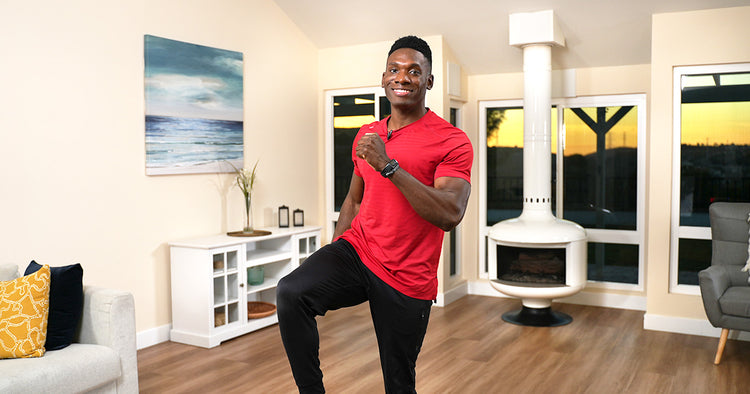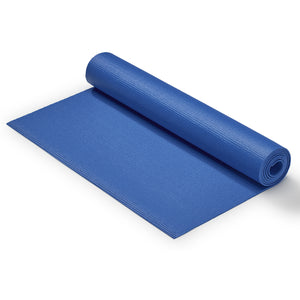If you’ve ever been injured, you know how long and grueling the path to recovery can be. Thankfully, your odds of avoiding this altogether are greatly increased by incorporating dynamic flexibility, balance, and strength training into your fitness routine. Here are 6 exercises for lower body injury prevention to keep you moving safely!
Ankle
One study of trail runners found that ankle sprains are the most common acute injury(1). While this may be cause for concern, the good news is that your risk of sustaining an ankle injury can be minimized through preventative measures. A study of soccer players found that implementing strength and balance training exercises cut rates of ankle injury by more than a third(2).
Foot Wings
This exercise will help strengthen the smaller stabilizer muscles surrounding the foot and ankle.
How To:
- Begin in a seated position with your working leg extended in front of you.
- Slightly plantarflex your foot (point your toes).
- Think of “winging” your foot inward (inversion) for 10 repetitions. You will do this by contracting the muscles on the inside of your foot and ankle to draw the toe toward the midline of the body.
Single Leg Balance
This is a fantastic exercise that you can easily incorporate into your daily routine while brushing your teeth, cooking, or waiting for the bus. The Single Leg Balance will teach your ankle how to effectively stabilize when only one foot is on the ground.
How To:
- Begin by standing with both feet underneath you, shoulder width apart.
- Slowly shift your weight from one foot to the other, until all your weight is rooted in one foot.
- Lift the opposite foot off the floor and balance here as long as you can. If you fall out of it, no worries, just recalibrate and try to find your balance again.
- Extra Challenge - try bending the knee of your standing leg and extending the opposite leg forward, then straighten your knee and bring the opposite leg back toward your center. You can also do this while reaching your leg to the side as well as extending behind you.
Knees
Leg Swings
The Journal of Orthopaedic & Sports Physical Therapy recommends incorporating dynamic flexibility training as the primary means of knee injury prevention(3). Leg swings are a great exercise to dynamically improve the flexibility of the quadriceps and hamstrings.
How To:
- Begin by balancing on one leg, using that same side arm to hold onto the wall, back of a chair, or other stable item to help balance.
- Swing your leg forward and back, letting the momentum naturally bring your leg to its furthest points of hip flexion and extension.
Lunges
Strength training also goes a long way in maintaining stable, healthy knees. Lunges are an excellent movement to challenge the strength and stability of your knees. This exercise will work the same muscles you use while walking, jogging, or running.
How To:
- Begin standing with both feet underneath you, shoulder-width apart.
- Step directly forward with one leg, maintaining the same width the entire time.
- Bend both knees until approximately 90 degrees of flexion, then drive down through the heel of your forward leg and step back to bring both legs back underneath you.
*This might be tricky to get the hang of at first. For more on proper movement mechanics while executing lunges.
Hips
The hip joints take a tremendous amount of strain as they are responsible for shifting weight from one foot to the other while walking, running, and performing nearly all other lower-body movements(4). Exercises that strengthen the muscles surrounding the hips and trunk are an effective measure of injury prevention when incorporated regularly(5).
Clamshells
This exercise will help target your Glute Medius which is often weak from being underutilized. One study even found a link between low back pain and weakness of the Glute Medius. Although this is a hip exercise it can potentially help alleviate low back pain in addition to strengthening your hips(6).
How To:
- Start by lying on your side, finding 90-degree flexion at the hips and knees.
- While engaging the core to minimize any twisting in the spine, externally rotate at the hip joint to move the legs away from each other. You can also think of opening the legs like a clamshell, then slowly relaxing to close the shell.
Bridges
Glute bridges train the strength and stability of the hip joint and core, as well as potentially improving your posture(7).
How To:
- Begin by laying on your back, legs bent at a 90-degree angle at your knees, and feet about shoulder-width apart.
- Drive down into your heels to lift your hips off the floor.
- Feel the backs of your legs (hamstrings and glutes) contract, then lower your hips back down to the floor.
But... What if I Still Get Injured
Life happens. Even those with extensive injury prevention routines may still find themselves injured. However, 70% of musculoskeletal injuries are due to overuse, so this might also be your body’s way of telling you to slow down(1). Rest is essential for recovery and should also be integrated into your fitness routine. If you are partaking in moderate-high intensity exercise, try taking at least one or two days off a week. Rest days can still include low-intensity movements like walking, mobility, stretching, and even incorporating some of the aforementioned injury-prevention exercises!
Wrapping It All Up
While these might not be the most glamorous or enjoyable exercises, they go a long way in helping you maintain a strong and healthy body that can move injury-free. If you are looking to follow a more structured injury prevention routine, check out my Injury Prehab/Rehab workouts for the ankles, hips, and spine on the SunnyFit® App. For a more bite-sized place to start, I challenge you to incorporate at least one injury-prevention exercise into your routine this week. From there, see if you can try to keep up with doing it every week going forward. It’s a small task now that could be saving your future self A LOT of pain and discomfort.


1. Vincent, H. K., Brownstein, M. J., & Vincent, K. R. (2022). Injury prevention, safe training techniques, rehabilitation, and return to sport in trail runners. Arthroscopy, Sports Medicine, and Rehabilitation, 4(1), e151–e162. https://doi.org/10.1016/j.asmr.2021.09.032. Accessed 5 April 2024.
2. Attar, W. S. a. A., Khaledi, E. H., Bakhsh, J. M., Faude, O., Ghulam, H., & Sanders, R. (2022). Injury prevention programs that include balance training exercises reduce ankle injury rates among soccer players: a systematic review. Journal of Physiotherapy, 68(3), 165–173. https://doi.org/10.1016/j.jphys.2022.05.019. Accessed 5 April 2024.
3. Knee injury prevention: Exercises to keep you from getting sidelined. (2018). Journal of Orthopaedic & Sports Physical Therapy, 48(9), 734. https://doi.org/10.2519/jospt.2018.0509. Accessed 5 April 2024.
4. Scopp, J. M., & Moorman, C. T. (2001). THE ASSESSMENT OF ATHLETIC HIP INJURY. Clinics in Sports Medicine, 20(4), 647–660. https://doi.org/10.1016/s0278-5919(05)70277-5. Accessed 5 April 2024.
5. Short, S. M., MacDonald, C. W., & Strack, D. (2021). Hip and Groin Injury Prevention in Elite Athletes and Team Sport – Current Challenges and Opportunities. The International Journal of Sports Physical Therapy, 16(1). https://doi.org/10.26603/001c.18705. Accessed 5 April 2024.
6. Sadler, S., Cassidy, S., Peterson, B., Spink, M. J., & Chuter, V. (2019). Gluteus medius muscle function in people with and without low back pain: a systematic review. BMC Musculoskeletal Disorders, 20(1). https://doi.org/10.1186/s12891-019-2833-4. Accessed 5 April 2024.
7. Tobey, K., & Mike, J. (2018). Single-Leg Glute Bridge. Strength and Conditioning Journal, 40(2), 110–114. https://doi.org/10.1519/ssc.0000000000000323. Accessed 5 April 2024.



























Add Your Name & Email
Please enter your name and email to continue.We won’t display your email publicly.